
MLKL Activation and Oligomerisation analysis using cross-linking LC-MS and Native Mass Spectrometry
1 /
6Pages
Catalog excerpts
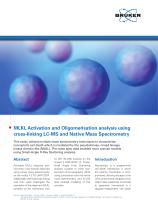
MLKL Activation and Oligomerisation analysis using cross-linking LC-MS and Native Mass Spectrometry This study utilized multiple mass spectrometry techniques to characterise necroptotic cell death which is mediated by the pseudokinase, mixed lineage kinase domain-like (MLKL). The mass spec data enabled more precise models using Small-Angle X-Ray Scattering analysis. Abstract Activated MLKL oligomer stoichiometry was directly observed using native mass spectrometry on the maXis II ETD UHR-QTOF. Additionally, chemical cross-linking was then used investigate the orientation of the oligomeric MLKL complex on the membrane with LC-MS (XL-MS) analysis on the Impact II UHR-QTOF [1]. Finally, Small Angle X-ray Scattering analysis coupled to inline sizeexclusion chromatography (SEC) using constraints from the native mass spectrometry and XL-MS data enabled modeling of this complex. Introduction Necroptosis is a programmed cell death mechanism in which the plasma membrane is compromised, allowing escape of the cell’s contents and instigation of an inflammatory response. In contrast to apoptosis, necroptosis is a caspase-independent cell death Authors: Jarrod J Sandow 1,2, Emma J Petrie 1,2, Andrew I Webb 1,2, James M Murphy 1,2; 1 he Walter & Eliza Hall Institute of Medical Research, Parkville, Victoria, Australia; 2 Department of Medical Biology, The University of Melbourne, T Parkville, Victoria
Open the catalog to page 1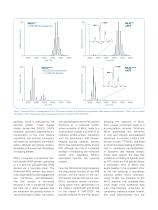
MLKLWT +ATP Relative intensity [%] Relative intensity [%] Relative intensity [%] Figure 1: Tetrameric MLKL is destabilized by ATP or PsK domain mutation to a monomeric intermediate. Mass spectra of wild-type and E351KMLKL with or without the addition of ATP measured by native mass spectrometry on the maXis II ETD UHR-QTOF pathway, which is executed by the terminal protein, mixed lineage kinase domain-like (MLKL). MLKL activation promotes oligomerization, translocation to the inner plasma membrane and ensuing necroptotic cell death by membrane permeabilization, although the precise molecular...
Open the catalog to page 2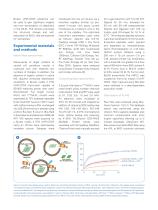
Bruker UHR-QTOF platforms can be used to gain significant insights into how reorientation of sidechains in the MLKL PsK domain promotes the structural change and selfassociation of MLKL that are essential for necroptosis. Experimental materials and methods Native Mass spectrometry Native-spray of larger proteins at neutral pH conditions results in molecular ions with relatively low numbers of charges. In addition, the absence of organic solvent in native MS requires enhanced desolvation conditions. A Bruker maXis II ETD UHR-QTOF instrument capable of 80,000 resolving power was used....
Open the catalog to page 3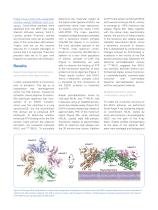
(https://www.wehi.edu.au/people/ andrew-webb/129 8/apl - mgf- con verter). Cross-linked peptides were identified from the MGF files using StavroX software (version 3.6.0.1). Lysines, protein N-termini, serines and threonines were set as reaction sites of the cross-linker NHS-esters. Trypsin was set as the enzyme allowing for 3 missed cleavages at lysines and 2 at arginines. Precursor precision was set at 10 ppm with fragment ion precision set at 20 ppm. Results Determining oligomer stoichiometry using native mass spectrometry In cells, cytosolic MLKL is monomeric prior to activation. This...
Open the catalog to page 4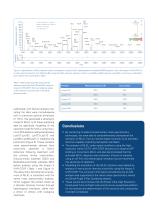
Theor. Mass (M+H): 1742.017 Observ. Mass (M+H): 1742.017 Deviation: -0.04 ppm m/z: 436.2597 +4 Table 1: Table presenting inter-subunit MLKL tetramer cross-links from DSS and BS3 using the Impact II UHR-QTOF. Minimum distance relates to the minimum cross-link span in the MLKL tetramer model subtracted, with Guinier analysis indicating the data were monodisperse with a maximum particle dimension of 170 A. We generated a tetrameric model of MLKL to fit these scattering data by rigid-body modelling of the reported model for MLKL using maximum 35 A distance restraints between Lys157-Lys157,...
Open the catalog to page 5
Learn More You are looking for further Information? Check out the link or scan the QR code for more details. [1] Petrie EJ, Sandow JJ (2018) Conformational switching of the pseudokinase domain promotes human MLKL tetramerization and cell death by necroptosis. Nat. Comm. Jun 21;9(1):2422 [2] Marty MT. (2015 ) Bayesian deconvolution of mass and ion mobility spectra: from binary interactions to polydisperse ensembles. Anal Chem. Apr 21;87(8):4370-6). [3] Forbes S.A. et al. (2017). COSMIC: somatic cancer genetics at high-resolution. Nucleic Acids Res 45, D777-D783. [4] Murphy J.M. et al....
Open the catalog to page 6All Bruker Daltonics Inc. catalogs and technical brochures
-
Label-Free Molecular Imaging
12 Pages
-
MALDI Biotyper® CA System
12 Pages
-
IntelliSlidesTM
2 Pages
-
CMC-assist
2 Pages
-
Toxtyper
8 Pages
-
Product Overview
16 Pages
-
spotOn™
4 Pages
-
Metabolomics
8 Pages
-
BioPharma Compass® 2.0
8 Pages
-
TASQ Software
4 Pages
-
timsTOF™
8 Pages
-
TargetScreener
6 Pages
-
timsTOF Pro
6 Pages
-
Quant Proteomics
8 Pages
-
MBT Galaxy RUO
4 Pages
-
MBT Pilot RUO
4 Pages
-
MBT SMART IVD
4 Pages
-
MBT Consumables RUO
4 Pages
-
MBT Sepsityper
6 Pages
-
MBT BTS US
2 Pages
-
MBT Disposable Targets US
2 Pages
-
MBT Pharma
8 Pages
-
MALDI Imaging
16 Pages
-
rapifleX™ MALDI Tissuetyper™
8 Pages
-
PesticideScreener 2.0
8 Pages
-
MBT Mycobacteria Library
4 Pages
-
MALDI Biotyper Clinical IVD
6 Pages
-
MALDI Biotyper CA System
12 Pages
-
Bruker ToxScreener
6 Pages
-
ProteinScape
8 Pages
-
maxis II
12 Pages
-
EVOQ
6 Pages
-
impact II
12 Pages
-
micrOTOF II
8 Pages
-
ImagePrep
4 Pages
-
DE-tector
6 Pages
-
pTD
2 Pages
-
RAID AFM
4 Pages
-
RAID XP
4 Pages
-
RAID S2
6 Pages
-
RAID M100
6 Pages
-
MM2
6 Pages
-
SVG 2 and Probes
6 Pages
-
µRAID
4 Pages
-
VeroTect
4 Pages
-
SIGIS II
2 Pages
-
solarix XR
12 Pages
-
The new autoflex speed
10 Pages
-
Product Overview
20 Pages
-
impact HD
12 Pages
-
Radiation Backpack Sentry
4 Pages
-
Toxtyper
6 Pages
-
micrOTOF-Q III
6 Pages
Archived catalogs
-
EVOQ - 2014
6 Pages

































































